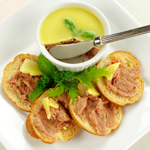
Guilt! I know I carry it along with me about a great many instances and occurrences: things I have done, things I have not done, and things I have failed to do. I don’t know if it is my Catholic upbringing or just a sense of self-masochism, but guilt follows me perpetually.
In the realm of food, some allow guilt to guide them to a vegetarian, pescetarian or a vegan diet so that they do not participate in what they feel to be cruel treatment of animals. Personally, I do not allow the contribution of food-based guilt to inhibit my guilty food pleasures.
I do not argue that animals should live the most comfortable life possible within reason. Instead, certain food products should be researched before turning a blind eye. There are specific instances, aside from the argument of antibiotics, where buying food products of more humanely raised animals not only contribute to their overall wellness, but to ours, too.
Cows raised on a natural diet of grass (instead of the industry standard of corn and animal meal) live a less bloated life and give us better tasting meat. Free-range chicken eggs not only taste better but also have an abundance of nutrients not found in ones produced, again, on a corn diet.

Veal, the meat of baby calves (mostly male) that traditionally had been kept from excess movement, prevent the toughening of the meat. There have been many measures decreasing full restraint and increasing quality of life (for as little time as that may be). When shopping, look for calves that give us veal that have been mother-milk fed and were raised free range, allowed to roam freely for their limited life span, fed also on grass and grains, without antibiotics and delicious once breaded and baked.
Less common but arguably more detested is foie gras. The buttery-smooth and delicious engorged liver of a force-fed French goose. The qualities of the liver are imparted to the organ by feeding the goose enough grains that the liver does not have enough time to process all the contents to waste and, instead, deposits the excess fats to the liver.
Of course there are options other than a “gavage”-ed goose if you would like to enjoy the creamy texture of foie gras: some (non-French) productions time the slaughter of the goose so that it synchs with the natural overeating of the bird just before migration time. Another option is to infuse chicken livers with butter and heavy cream that is turned into a mousse-like pâté that I call a faux gras (recipe included). Although it will never match true foie gras, it just might make you a better foodie who can live guilt-free. bobby’s recipe
bobby’s recipe
Faux gras
This recipe is great as a starter for parties and does not have a strong liver flavor to ease your less adventurous guests into the realms of pâté or foie gras.
4 cups water
1 lb. chicken livers
1/4 brick of soft tofu
1/2 cup brandy
1 cup diced shallots
2 tablespoons butter
2 minced garlic cloves
1/2 cup heavy cream
1 3/4 sticks butter
melted ghee or clarified butter
Do ahead: drain and trim the chicken livers then roughly chop. Cube the tofu, combine with the livers and let soak in the brandy for at least one hour then drain before use.
Preheat the oven to 350 degrees and place the rack in the middle. Bring the water to a simmer.
 Over a moderately low heat, sauté the shallots in the butter until translucent (10 minutes or less). Stir in the garlic cloves and the heavy cream. Increase the heat to medium high and sauté until the cream has reduced and the shallots have absorbed most of the liquid (about 15 minutes). Remove from heat and stir in the sticks of butter, return to heat and stir until the butter is melted and combined.
Over a moderately low heat, sauté the shallots in the butter until translucent (10 minutes or less). Stir in the garlic cloves and the heavy cream. Increase the heat to medium high and sauté until the cream has reduced and the shallots have absorbed most of the liquid (about 15 minutes). Remove from heat and stir in the sticks of butter, return to heat and stir until the butter is melted and combined.
Combine the onion mixture with the liver and tofu and homogenize using an immersion or counter blender. Pass the mixture through a fine mesh sieve and set aside.
Space four 8-ounce ramekins in a roasting pan or other, shallow, oven proof dish. Pour the liver mixture evenly between the ramekins; cover each with foil, then fill the bottom of the pan 1/3 full with simmering water. Bake until the pâté is just set (about 30 minutes) and chill, covered, for at least three hours.
Once the pâté is cold, seal the ramekins by pouring barely melted ghee (or clarified butter) over the tops so that it covers the pate and forms a seal once chilled. An alternative method (which will keep for less time) is to cover the tops with a gelée that has been prepared with fresh chopped parsley.
Allow the pâté to come up to room temperature (about 30 minutes) and serve with toast points, some softened Gorgonzola cheese, or whatever else suits your fancy. I also like to prepare a roasted tomato confit but will leave you to conjure that recipe.










